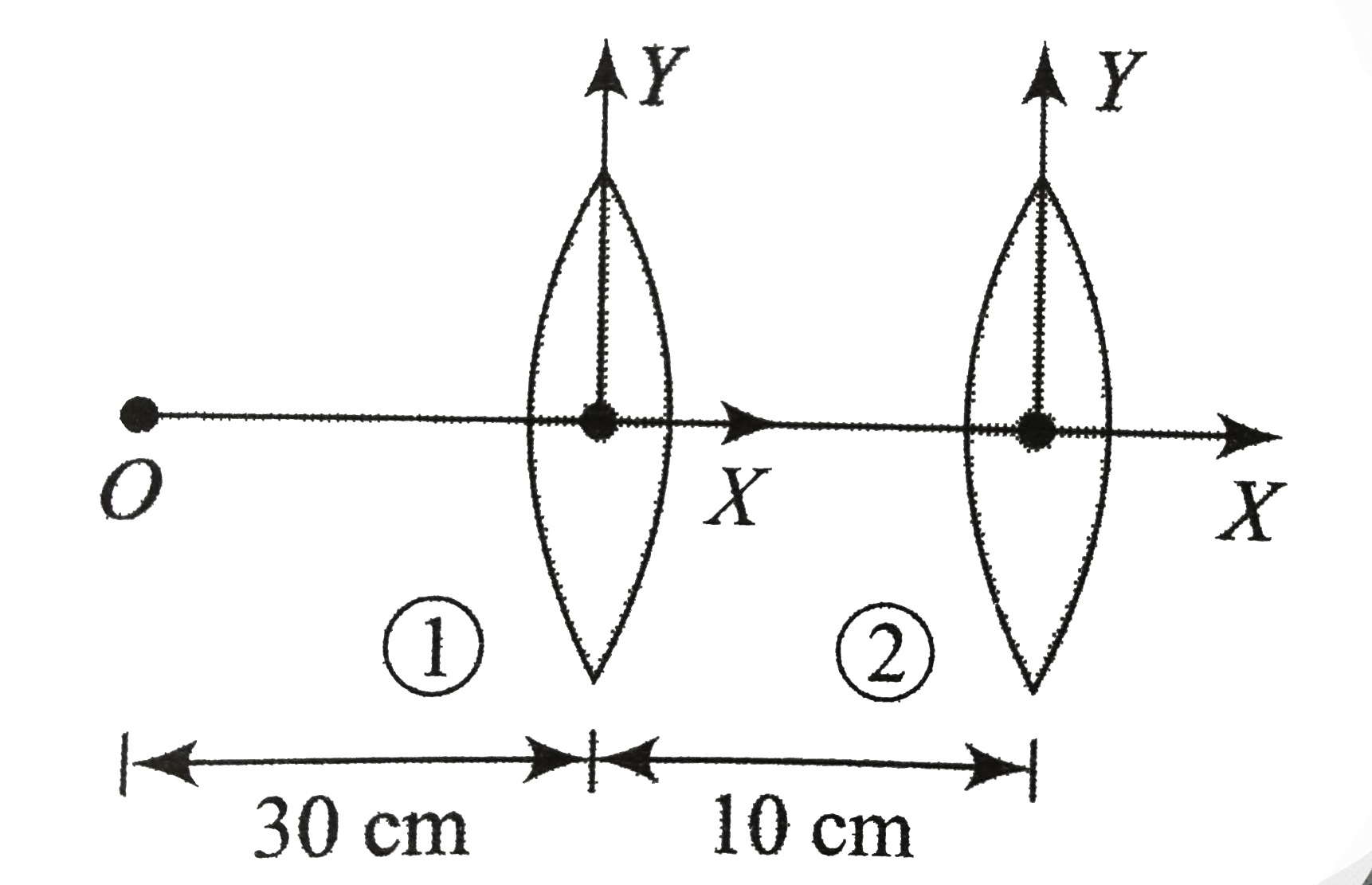A telephoto combination consists of convex lens of focal length 30cm and a concave lens of focal length 15cm, the separation between two lens is 27.5cm. Where should be the photographic plate placed in order to photograph an object 10m in front of the first lens?
To solve the problem of where to place the photographic plate in a telephoto combination of a convex lens and a concave lens, we will follow these steps:
Step 1: Understand the Configuration
We have a convex lens with a focal length f1=30cm and a concave lens with a focal length f2=−15cm. The separation between the two lenses is d=27.5cm. The object is placed u=−1000cm (since the object is in front of the lens, we take it as negative) from the convex lens.
Step 2: Find the Image Formed by the Convex Lens
Using the lens formula:
1f=1v−1u
For the convex lens:
130=1v1−1−1000
Rearranging gives:
1v1=130+11000
Step 3: Calculate v1
Finding a common denominator (which is 3000):
130=1003000,11000=33000
Thus,
1v1=100+33000=1033000
So,
v1=3000103≈29.13cm
Step 4: Determine the Position of the Image Relative to the Concave Lens
The image formed by the convex lens acts as an object for the concave lens. The distance of this image from the concave lens is:
u2=d−v1=27.5−29.13=−1.63cm
(Note: The negative sign indicates that the image is on the same side as the object for the concave lens.)
Step 5: Find the Image Formed by the Concave Lens
Using the lens formula again for the concave lens:
1−15=1v2−1−1.63
Rearranging gives:
1v2=1−15+11.63
Step 6: Calculate v2
Finding a common denominator (which is approximately 24.45):
1−15=−0.0667,11.63≈0.6135
Thus,
1v2=−0.0667+0.6135≈0.5468
So,
v2≈10.5468≈1.83cm
Step 7: Position of the Photographic Plate
The photographic plate should be placed at a distance of approximately 1.83cm on the opposite side of the concave lens from the image formed by it.
Summary
To photograph the object, the photographic plate should be placed approximately 1.83cm from the concave lens.
We have a convex lens with a focal length f1=30cm and a concave lens with a focal length f2=−15cm. The separation between the two lenses is d=27.5cm. The object is placed u=−1000cm (since the object is in front of the lens, we take it as negative) from the convex lens.
Using the lens formula:
1f=1v−1u
For the convex lens:
130=1v1−1−1000
Rearranging gives:
1v1=130+11000
Finding a common denominator (which is 3000):
130=1003000,11000=33000
Thus,
1v1=100+33000=1033000
So,
v1=3000103≈29.13cm
The image formed by the convex lens acts as an object for the concave lens. The distance of this image from the concave lens is:
u2=d−v1=27.5−29.13=−1.63cm
(Note: The negative sign indicates that the image is on the same side as the object for the concave lens.)
Using the lens formula again for the concave lens:
1−15=1v2−1−1.63
Rearranging gives:
1v2=1−15+11.63
Finding a common denominator (which is approximately 24.45):
1−15=−0.0667,11.63≈0.6135
Thus,
1v2=−0.0667+0.6135≈0.5468
So,
v2≈10.5468≈1.83cm
The photographic plate should be placed at a distance of approximately 1.83cm on the opposite side of the concave lens from the image formed by it.
To photograph the object, the photographic plate should be placed approximately 1.83cm from the concave lens.
Topper's Solved these Questions
- GEOMETRICAL OPTICSBOOK - CENGAGE PHYSICS ENGLISHCHAPTER - GEOMETRICAL OPTICSEXERCISE - Subjective
26 Videos
- GEOMETRICAL OPTICSBOOK - CENGAGE PHYSICS ENGLISHCHAPTER - GEOMETRICAL OPTICSEXERCISE - Single Correct
221 Videos
- GEOMETRICAL OPTICSBOOK - CENGAGE PHYSICS ENGLISHCHAPTER - GEOMETRICAL OPTICSEXERCISE - Exercise1.6
15 Videos
- ELECTRON,PHONTS,PHOTOELECTRIC EFFECT & X-RAYSBOOK - CENGAGE PHYSICS ENGLISHCHAPTER - ELECTRON,PHONTS,PHOTOELECTRIC EFFECT & X-RAYSEXERCISE - dpp 3.3
15 Videos
- HEATING EFFECT OF CURRENTBOOK - CENGAGE PHYSICS ENGLISHCHAPTER - HEATING EFFECT OF CURRENTEXERCISE - Thermal Power in Resistance Connected in Circuit
27 Videos
Similar Questions
A convex lens of focal length 80 cm and a concave lens of focal length 50 cm are combined toghether. What will be their resulting power ?
View SolutionA convex lens of focal length 40 cm is in contact with a concave lens of focal length 25 cm. The power of the combination is
View SolutionA convex lens of focal length A and a concave lens of focal length B are placed in contact. The focal length of the combination is
View SolutionA convex lens A of focal length 20cm and a concave lens B of focal length 10 cm are kept along the same axis with a distance d between them. If a parallel beam, then d is
View SolutionA convex lens A of focal length 20cm and a concave lens B of focal length 10 cm are kept along the same axis with a distance d between them. If a parallel beam, then d is
View SolutionA convex lens of power +2.5D is in contact with a concave lens of focal length 25 cm. The power of combination is
View SolutionA convex lens of focal length 20cm is placed 10cm away from a second convex lens of focal length 25 cm. What wil be the location of the image of an object at 30 cm in front of the first lens?

View SolutionA convex lens of focal length 20 cm and a concave lens of focal length 10 cm are placed 20 cm apart. In between them an object placed at distance x from the convex lens.
What is the value of x (in cm ) so that images from by both the lenses coincides ?
View SolutionA thin convex lens of focal length 20 cm is kept in contact with a thin concave lens of focal length 15 cm. Find the focal length and the nature of the combination.
View SolutionA diverging lens of focal length 20 cm and a converging mirror of focal length 10 cm are placed coaxially at a separation of 5 cm. Where should an object be placed so that a real image is formed at the object itself ?
View Solution
